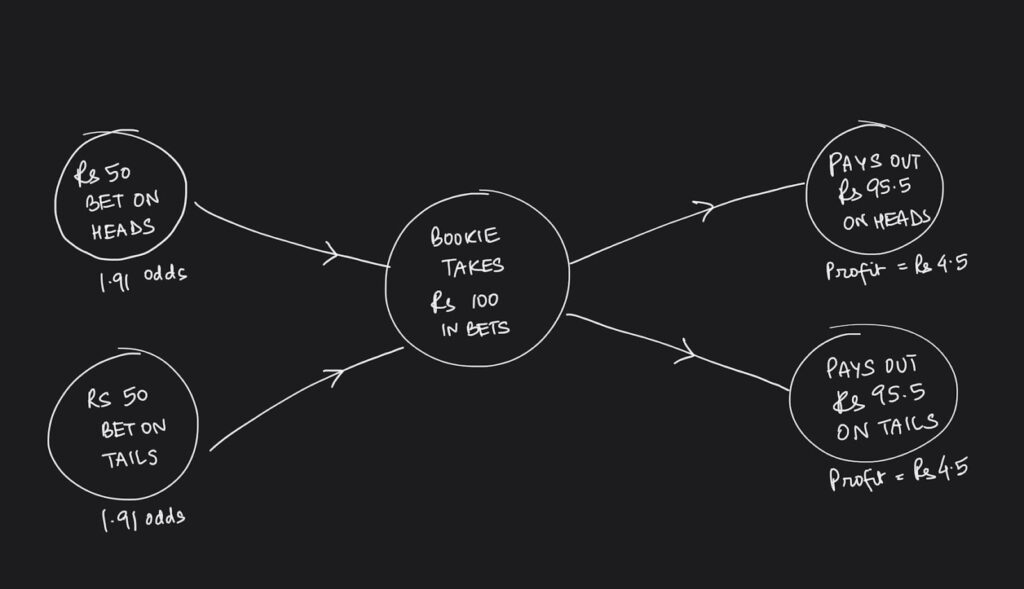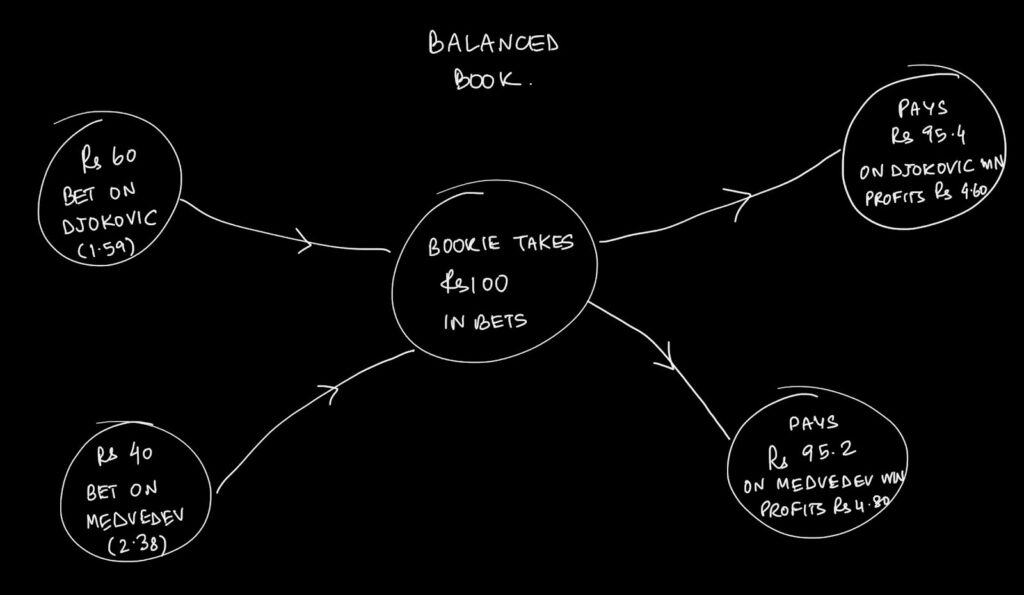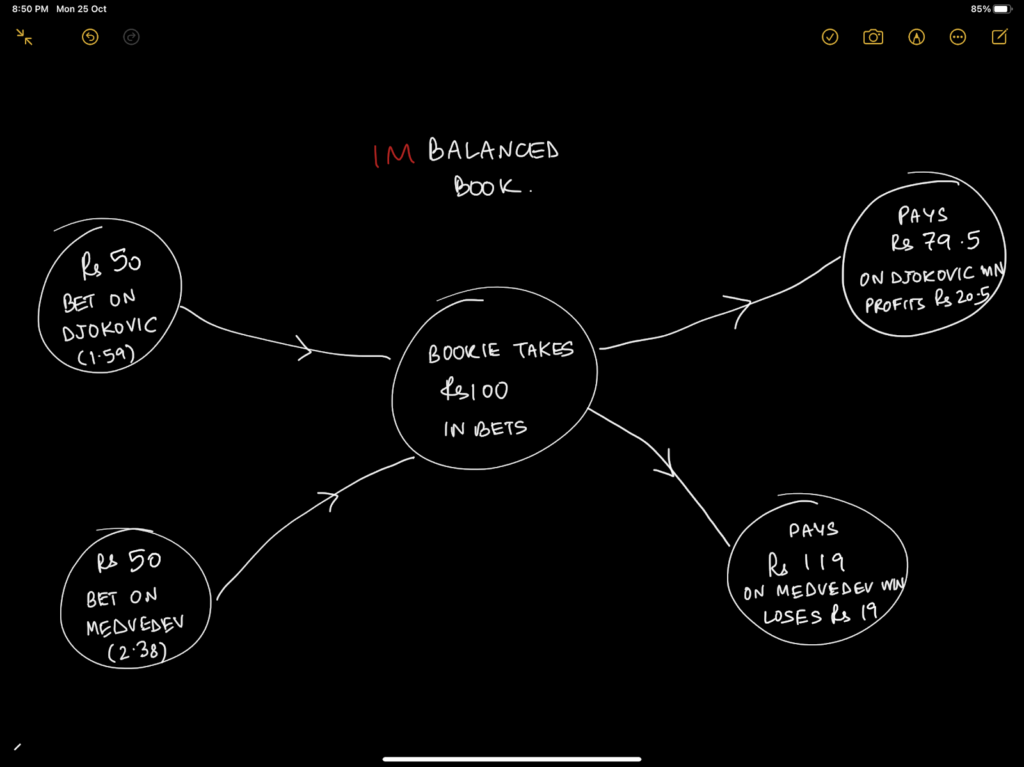
Bookmakers or bookies are essentially your opponents when you bet on a cricket match or a horse race. In India, you may find bookies:
- Online, at a sports betting site
- Near a racecourse
When you bet on who will win a match or whether the next ball will be a runout, your winnings depend on the results but also on the terms that the bookie sets. We’ll look at how this happens in greater detail below.
To start with, a bookie is the person who:
- sets the odds in a bet
- accepts your bet
- places your bet for you,
- and pays out your winnings.
When you bet online at a website, there are bookies behind the scenes doing all the things a human bookie would do. There are experts behind the scenes of the betting site just as at a racecourse.
These people can’t control the outcomes of matches. But they can control how much they stand to win or to lose on each outcome.
They always make it so they are at an advantage against bettors. Let’s take a look at how this works.
How do bookies make their money?
Bookies make money:
- because most people place bad bets or,
- don’t understand how to overcome the bookie’s advantage.
Knowing how bookies set their advantage will help you overcome this advantage.
Bookies don’t place bets themselves. They are able to earn because they try to pay out less than they take in.
In other words, they try to maintain a balance in the books by adjusting the odds such that there’s an even number of people betting on a loss or a win.
How do they do this? Very simply – by pricing the bets they accept from you in a way that gives them an advantage. Their pricing doesn’t reflect the true odds of the outcome.
Let’s look at a simple illustration to understand the bookie’s margin. The bookie’s margin is, in a way, the commission they charge for the service of placing your bet.
If you know how they price the margin, you can recognize when bookies are offering poor value in the betting exchange. You can then turn your knowledge to your advantage and earn profits.

A simple illustration of bookie’s margins
To understand bookmakers’ margins, let’s take the simple case of a coin toss. When you toss a coin, what’s the chance it will land either on Head or on Tails?
| Coin toss outcome | Probability |
| Heads | ½ or 50% |
| Tails | ½ or 50 % |
There are only two possible outcomes for every coin toss and each outcome is equally likely.
So, the chance of either Heads or Tails is 1:2.
If a bookie was a fair bookie offering even money on true odds, he’d be offering odds of 2.0 in decimals or 1:1 in fractions. Let’s take a look at what this means with a scenario.
Supposing he takes 100 bets on a coin toss and everyone bets a rupee. Here’s what will happen:
- 50 people will bet Heads
- 50 people will bet Tails
The bookie will not earn anything.
He would have to pay the first 50 betters a total of fifty rupees (their total initial bet) plus 50 rupees profit. He would earn fifty rupees from the second group, but this money would go as profits to the first group.
This is not ideal for the bookie. Let’s see what the bookie will do instead.
The bookmaker always wants to have a mathematical advantage over you. So they will offer lower odds than what they believe the true probabilities are.
The bookmaker’s margin is how much the price they are offering deviates from what the ‘true odds’.
In the above example, the interested bookie would offer bets at odds below 2. It’s common to offer odds of 1.91 in decimals or 10/11 in fractions, when two outcomes are equally likely.
So, for every 1 rupee you bet, you earn 1.91 rupees on winning, not 2 rupees.
Let’s see what that means for the bookmaker taking 100 bets of one rupee each. As before,
- 50 people bet on Heads
- 50 people bet on Tails
The bookie earns a total of 50 rupees from the second group if the outcome of the toss is Heads. But he doesn’t have to pay 50 + 50 rupees to the first group. He pays them 50 rupees for their initial stakes plus 1.91 x 50 = 95.5 rupees.
So for every 100 rupees the bookie takes in a coin toss, he earns 4.5 rupees. In other words, 4.5% is his profit margin on every bet.

This simple example should explain the concept of odds. How bookies set the odds on a real match where two outcomes aren’t equally likely is more complex.
How do bookies come up with odds in a real game?
Many free online services will allow you to compare the odds offered by different bookmakers. How do they calculate the odds?
Some bookmakers have in-house experts who look at a number of factors that could affect the probabilities of a team winning, such as:
- lineups,
- league positions,
- recent performances,
- losing or winning streaks.
It needs a combination of statistics and sports knowledge to calculate the odds.
The experts will help the bookie’s to:
- Set their odds
- Balance their books

Setting odds
Let’s look at a more real-world example to calculate odds. How about a tennis match between two players with very similar abilities, like Novak Djokovic and Daniil Medvedev? The bookie’s experts will consider their current form, their past performance on the type of court they’re playing on as well as their past performances against each other.
They may decide Djokovic has around 60% chance of winning the match and Medvedev 40%. The odds that reflect these chances are around 1.67 for Djokovic and 2.50 for Medvedev. Now the experts will have to calculate the bookie’s margins.
Let’s assume here the bookies add a margin of 5 %. To do so, they will reduce the odds for each player by 5%. This would mean odds of:
- 1.59 for Djokovic
- 2.38 for Medvedev
To calculate the bookie’s margin, there are several formulas. One simple model is to add the inverse of odds for all possible outcomes and write it as a percentage. In the above game, there are 2 possible outcomes, so the bookie’s margin will be:

It is clear that the expert has achieved a margin of 5%.
But this is not the end.
Balancing the books
The bookie’s expert will also usually try to help the bookie maintain a balanced book. What does that mean?
In the tennis match above, for instance, here’s what a balanced book might look like if the bookie took in a total of 100 one-rupee bets.
Total bets on Djokovic (at 1.59) = 60 rupees
Total bets on Medvedev (at 2.38) = 40 rupees
Let’s assume the target of 5% margin.
If Djokovic wins, the bookie pays out 95.4 rupees and profits 4.60 rupees.
If Medvedev wins, he pays out 95.2 rupees and profits 4.80 rupees.
With either outcome and a balanced book, the bookie wins roughly 5 rupees.

What does an imbalanced book look like? Here’s what happens if the total bets were spread across both players evenly.
Total bets on Djokovic (at 1.59) = 50 rupees
Total bets on Medvedev (at 2.38) = 50 rupees
Let’s assume a target margin of 5% again.
In this scenario, if Djokovic wins, the bookie pays out 79.5 rupees and profits 20.5 rupees.
If Medvedev wins, the bookie pays out 119 rupees and loses 19 rupees.

This is the scenario that the bookie wants to avoid.
This is also exactly why the odds change continually on sports events. The bookie’s experts are continuously trying to balance the books.
In the scenario above, they could reduce the odds on Medvedev to discourage bets on his wins and increase the odds on Djokovic.
Also, it’s easy to see why the volume of bettors matters to bookies. The greater the volume, the better the chances of a balanced book.
Know how to calculate betting margins
Here are a few other things to keep in mind the next time you’re sports betting:
- The higher the margin, the lower the value for the bettor.
- Live-betting margins are higher than pre-match margins.
- It is helpful to know that in Asia, the operating models bookies follow are slightly different from European betting markets. Bookies here tend to operate with higher odds and lower margins. But they have high turnovers, which allows them to make profits.
- Maximum stakes in Asian sports betting also tend to be higher.
- Asian bookies tend to change odds often.
Once you know how to calculate odds, you can compare bookmakers for yourself and find the best odds and lowest margins for an event to bet on.
Margin calculations will be different depending on whether it’s a two-way event, like tennis, or a 1×2 event like On Online cricket Betting sites.
Also remember, formulae to calculate margins for events like cricket will be slightly different from that of tennis matches.
How bookies make money by pitch-siding or court-siding
Sometimes in live betting, bookies are able to avoid paying out to bettors who would have won, keeping the money they bet. They do this by something called court-siding or pitch-siding.
- They plant insiders at a sports venue. These people take advantage of the lag between an event – such as a sixer on the 23rd ball – and the moment when people see it on TV or an online scoreboard.
- There may be a lag of as much as 20 seconds between the event and its televising or online updating. The insider calls the bookie in that window.
- The bookie then rejects all bets that bet on a sixer on the 23rd ball and accepts all the other losing bets. He doesn’t have to pay the bettors who bet on the sixer, because their bets weren’t registered.
In this way, the bookie is able to game the system and make money.
Conclusion
Bookies in India are driven by the market, so they’ll constantly be changing the odds to balance the books. Once you realize this and learn how to calculate the betting margins, you’ll find it easier to override the edge that bookies have over you. You’ll be able to find out if the odds offered are mis-priced when compared to the true probability.
This will allow you to place a value bet that will overcome the bookmaker’s margin. You’ll know where the best value lies and where you should place your bets.
Also Read Our Review on























